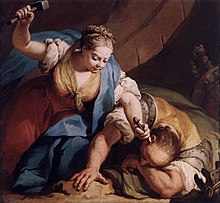


The "Power of Women" (German: Weibermacht) is a medieval and Renaissance artistic and literary topos, showing "heroic or wise men dominated by women", presenting "an admonitory and often humorous inversion of the male-dominated sexual hierarchy".[2] It was defined by Susan L. Smith as "the representational practice of bringing together at least two, but usually more, well-known figures from the Bible, ancient history, or romance to exemplify a cluster of interrelated themes that include the wiles of women, the power of love, and the trials of marriage".[3] Smith argues that the topos is not simply a "straightforward manifestation of medieval antifeminism"; rather, it is "a site of contest through which conflicting ideas about gender roles could be expressed".[4][5]
Smith argues the topos originates in classical literature[6] and finds it in medieval texts such as Aucassin et Nicolette, The Consolation of Philosophy, the Roman de la Rose, and the Canterbury Tales.[7] The topos was attacked by Christine de Pizan around 1400, who argued that if women wrote these accounts their interpretations would be different from those of men.[8]
In the visual arts, images are found in various media, mainly from the 14th century onwards, and becoming increasingly popular in the 15th century. By then the frequently recurring subjects include Judith beheading Holofernes, Phyllis riding Aristotle, Samson and Delilah, Salome and her mother Herodias, Jael killing Sisera, Bathsheba bathing in sight of David, the idolatry of Solomon, Virgil in his basket, as well as many depictions of witches, and genre images of wives dominating their husbands. The last group came to be called the battle for the trousers.[9] Joseph and Potiphar's wife and Lot and his Daughters were somewhat late joiners to the group, but increasingly popular later on.[10] Tomyris, the Scythian queen who defeated Cyrus the Great and abused his corpse, was painted by Rubens and several Italians.[11]
These scenes, mostly shown in consistent compositions involving just two persons and visually distinctive actions, were easily recognisable and seem to have also been represented dramatically in entertainments of various sorts, whether as short scenes or tableaux vivants.[12] It is not clear who first coined the term Weibermacht, but it had evidently gained currency in the sixteenth century Northern Renaissance in Germany and the Low Countries.[13]
- ^ "Aquamanile in the Form of Aristotle and Phyllis". Metropolitan Museum of Art.
- ^ Ainsworth, p. 59
- ^ Babinsky, Elen L. (1997). "Rev. of Smith, The Power of Women". Church History. 66 (2): 340–341. doi:10.2307/3170688. JSTOR 3170688. S2CID 162214167.
- ^ Smith, Susan L. (2006). Margaret Schaus (ed.). Women and Gender in Medieval Europe: An Encyclopedia. Taylor & Francis. pp. 844–845. ISBN 978-0415969444.
- ^ c.f. Nurse p. 1, who characterises it as arising from the complex religious and social turmoil provoked by the European Reformation of the sixteenth century.
- ^ Millett, Bella (22 September 1997). "Rev. of Smith, The Power of Women". Medium Aevum. Archived from the original on 5 July 2017. Retrieved 10 March 2015.
- ^ Harp p. 208
- ^ Wolfthal p. 57
- ^ Salomon, 87; "strijd om de broek" in sixteenth century Netherlandish literature and printmaking.
- ^ Russell, pp. 147–148, Nos 20–32 (Judith), 87–110, 120–125; Ainsworth, pp. 59–66; Salomon, pp. 87–88; Hall, 41–42
- ^ Hall, 305
- ^ Snyder, 461
- ^ Nurse p. 1